Motohistory Quiz
#78
(4/30/2010)
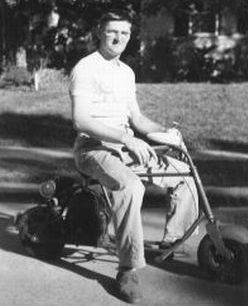 What is this man riding?
What is this man riding?
No, this is not a home-built
scooter. It is a manufacturer's serial production
model.
Name the manufacturer and you will be
declared our newest Motohistory Know-It-All, complete with
personalized diploma.
Be careful! It may not be what you
think it is.
Send your answer to Ed@Motohistory.net.
Motohistory
Exclusive
The Killinger & Freund
confirmed;
photographed in the United
States!
(4/30/2010)
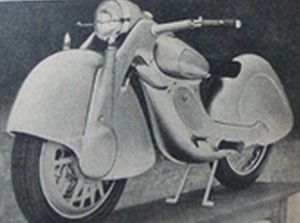 Last month we learned a lot about the
Killinger & Freund (pictured left) when we chose it as a
Motohistory Quiz (see Motohistory News & Views
3/31/2010). We learned that while it is one of the most
unusual motorcycles in the world—only a single prototype is
known to exist—it is one of the best known. We received
a flood of correct answers for the quiz, far more than we had
received for any previous quiz. We also learned that the
K&F is the source of interesting rumors, one being that it
was sold by a U.S. collector to a man in Germany years ago,
but that its whereabouts in Germany is not known.
Last month we learned a lot about the
Killinger & Freund (pictured left) when we chose it as a
Motohistory Quiz (see Motohistory News & Views
3/31/2010). We learned that while it is one of the most
unusual motorcycles in the world—only a single prototype is
known to exist—it is one of the best known. We received
a flood of correct answers for the quiz, far more than we had
received for any previous quiz. We also learned that the
K&F is the source of interesting rumors, one being that it
was sold by a U.S. collector to a man in Germany years ago,
but that its whereabouts in Germany is not known.
The reason that
people on the trail of the K&F have not found it in
Germany is because it is not there. It is still in the
United States, and Motohistory was given the opportunity to
photograph it, provided we would not disclose its location or
who currently has custody of it. These facts are know by
a few people in the antique motorcycling community, but they
are not talking for the same reason we agreed to safeguard the
information. The current custodian of the bike does not
want to be inundated with inquiries from the curious.
But what you see here is confirmation of the 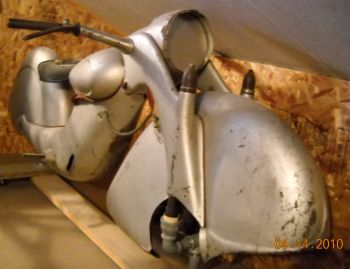 existence of the incredible
K&F. These photos, all date-stamped 4/14/2010, were
taken in the American Midwest.
existence of the incredible
K&F. These photos, all date-stamped 4/14/2010, were
taken in the American Midwest.
As reported
previously, the K&F was first shown at the Berlin
motorcycle show in 1938. It was an incredible machine in
every aspect, and immediately captured the imagination of the
public and press. If performance in production models
had lived up to the unique features of its design, it likely
would have changed the course of motorcycle design ever
after. But this did not happen, because Adolf Hitler was
too busy planning to change the course of history. It is
reported that production plans were laid for the K&F, and
that a batch of pre-production engines and gear 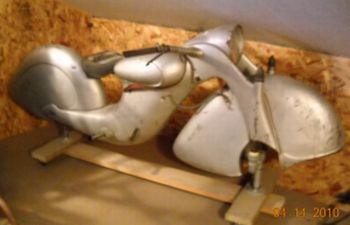 sets were made, but all came to a halt
when the Reich order that German industry direct all of its
efforts toward military mobilization.
sets were made, but all came to a halt
when the Reich order that German industry direct all of its
efforts toward military mobilization.
The K&F
prototype went into storage and was discovered and seized by
the U.S. Army at the end of the war. It was taken to the
Aberdeen Proving Grounds in Maryland, and was placed on
display there for a period of time. Later, it was
discovered in a scrap heap and purchased by American collector
Harry Buck. The rear hub (pictured below) was missing,
but later discovered in the possession of Karl Duffner, who
ran it on the front of his 1954 BMW R68 for nearly ten
years. Later, Duffner returned his bike to stock and the
wheel hung from the rafters of his shop for the next 30 years
(to read our feature about Karl Duffner, go to Motohistory
News & Views 11/30/2009). By connecting some
historical dots, a mutual friend put Duffner and Buck
together, and a deal 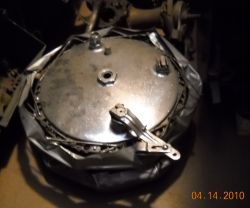 was struck to return the K&F hub to
the remains of the bike. The story that the motorcycle
had gone back to Germany was later concocted by Buck and the
current custodian of the bike to put an end to people calling
to see it or try to purchase it.
was struck to return the K&F hub to
the remains of the bike. The story that the motorcycle
had gone back to Germany was later concocted by Buck and the
current custodian of the bike to put an end to people calling
to see it or try to purchase it.
The sheet metal
shell, as pictured here, without the engine and wheels, is
surprisingly light. A man can lift it. It has
swinging arm rear suspension with hydraulic shock hidden i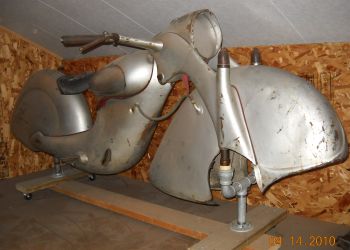 nside the body of the bike. Front
shocks are mounted nearly vertical so the bike’s wheel base
will not change significantly during operation. Today,
the bike is in remarkably good condition. Silver paint
is still intact and there are only tiny bits of surface rust
where the paint has been damaged. Only one or two minor
dents can be found on the body.
nside the body of the bike. Front
shocks are mounted nearly vertical so the bike’s wheel base
will not change significantly during operation. Today,
the bike is in remarkably good condition. Silver paint
is still intact and there are only tiny bits of surface rust
where the paint has been damaged. Only one or two minor
dents can be found on the body.
The K&F
engine (pictured below) is as unconventional as the
chassis. It is a surprisingly small unit designed to be
mounted in the 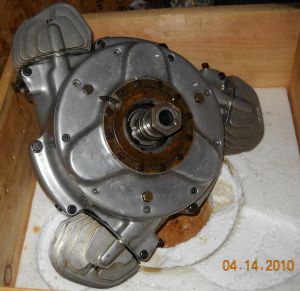 front wheel. It has been described
as a three-cylinder two-stroke, but it is far more complex
than this. Rather, it is three two stroke singles with
their cranks geared to a center drum which carries the clutch
and a two-speed transmission (see the drawing below). We
did not have a scale to weight the engine, but we estimate
that it did not weigh much more than 40
pounds.
front wheel. It has been described
as a three-cylinder two-stroke, but it is far more complex
than this. Rather, it is three two stroke singles with
their cranks geared to a center drum which carries the clutch
and a two-speed transmission (see the drawing below). We
did not have a scale to weight the engine, but we estimate
that it did not weigh much more than 40
pounds.
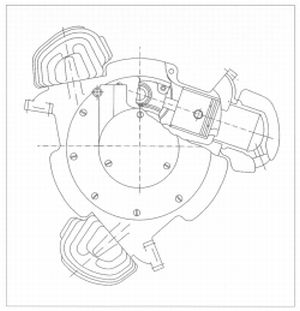 With so much original material at hand,
and in good condition, one might wonder why this historical
wonder has not been restored already. The fact that it
has been hidden away for so many years speaks to the reverence
the current holder has for this machine and the seriousness of
his task. He is a remarkable fabricator and skilled
machinist, but has chosen to leave the K&F in peace until
he has drawings or more original engineering
information. At this time, people in three countries are
on the hunt for drawings and more information. There is
little doubt that one day the incredible K&F will see the
light of day, and that the public will view it in a condition
close to that when it was unveiled in Berlin 72 years
ago.
With so much original material at hand,
and in good condition, one might wonder why this historical
wonder has not been restored already. The fact that it
has been hidden away for so many years speaks to the reverence
the current holder has for this machine and the seriousness of
his task. He is a remarkable fabricator and skilled
machinist, but has chosen to leave the K&F in peace until
he has drawings or more original engineering
information. At this time, people in three countries are
on the hunt for drawings and more information. There is
little doubt that one day the incredible K&F will see the
light of day, and that the public will view it in a condition
close to that when it was unveiled in Berlin 72 years
ago.
The Killinger
& Freund memorialized
Even with no
knowledge or interest in the amazing and unorthodox
engineering that lies beneath the skin of the K&F, one’s
imagination is excited by its visual impact alone. 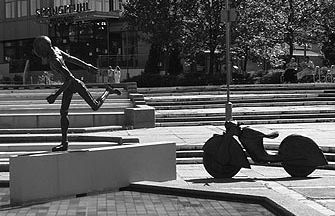 This was the case for artist and sculptor
Rolf Biebl, who placed a bronze sculpture of the motorcycle in
his “Well of Generations,” which graces the
Helene-Weigel-Platz in Berlin. Biebl memorializes not
only the futuristic K&F, but has placed near it the
sculpture of a motorcyclist, dressed in leathers and body
armor. Consider that Biebl had thousands of images of
motorcycles to choose from when he created his Well of
Generations in 1990. Rather, he chose a motorcycle that
had appeared only briefly some 50 years earlier, and left
little influence on the evolution of motorcycle design, thanks
to the outbreak of the Second World War. Biebl’s use of
the K&F is clear testimony of its beauty and appeal to the
modern eye. For more information about Rolf Biebl and
his work at German Wikipedia, click here.
For the story in English, click here.
For additional images of Helene-Weigel-Platz at Flickr,
including Biebl’s sculptures, click here.
This was the case for artist and sculptor
Rolf Biebl, who placed a bronze sculpture of the motorcycle in
his “Well of Generations,” which graces the
Helene-Weigel-Platz in Berlin. Biebl memorializes not
only the futuristic K&F, but has placed near it the
sculpture of a motorcyclist, dressed in leathers and body
armor. Consider that Biebl had thousands of images of
motorcycles to choose from when he created his Well of
Generations in 1990. Rather, he chose a motorcycle that
had appeared only briefly some 50 years earlier, and left
little influence on the evolution of motorcycle design, thanks
to the outbreak of the Second World War. Biebl’s use of
the K&F is clear testimony of its beauty and appeal to the
modern eye. For more information about Rolf Biebl and
his work at German Wikipedia, click here.
For the story in English, click here.
For additional images of Helene-Weigel-Platz at Flickr,
including Biebl’s sculptures, click here.
Killinger &
Freund:
Notes from a
designer
By Craig
Vetter
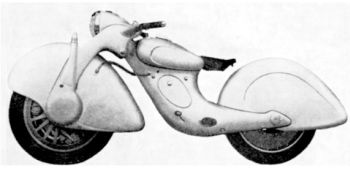 Ah, the 1938 Killinger &
Freund! I first discovered it on Page 84 of "Motorrader,
Motobuch Verlag Stuttgart,” written in German. It may
just be the finest example of streamlined style of the
era. I say “streamlined style” because it is not really
streamlined at all. Real streamlining is a smooth,
continuous shape, round at the front, and pointed at the rear.
Streamlining allows the least power to go the fastest
and farthest on the least amount of fuel. When
motorcycle designer and pioneer Glenn
Ah, the 1938 Killinger &
Freund! I first discovered it on Page 84 of "Motorrader,
Motobuch Verlag Stuttgart,” written in German. It may
just be the finest example of streamlined style of the
era. I say “streamlined style” because it is not really
streamlined at all. Real streamlining is a smooth,
continuous shape, round at the front, and pointed at the rear.
Streamlining allows the least power to go the fastest
and farthest on the least amount of fuel. When
motorcycle designer and pioneer Glenn 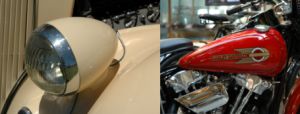 Curtiss realized this in 1920, his
airplanes went from 100 mph to 250 mph in just five years!
Curtiss realized this in 1920, his
airplanes went from 100 mph to 250 mph in just five years!
While
airplane manufacturers embraced streamlining immediately,
vehicle manufacturers never did, although they imitated the
shapes born from true streamlining. Think of the Auburn
automobile, the fuel tank of the 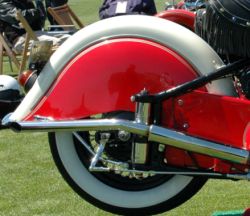 Harley-Davidson Knucklehead, or the
unforgettable lines of the 1940 Indian. Designers
learned that streamlining is easy to imitate but very
difficult to actually do.
Harley-Davidson Knucklehead, or the
unforgettable lines of the 1940 Indian. Designers
learned that streamlining is easy to imitate but very
difficult to actually do.
So,
except for specialized racing vehicles, streamlining for cars
and motorcycles has not progressed beyond a “look” or a
style. Headlights, fenders, gas tanks became rounded in
the front and pointed at the rear, but they were little more
than visual enhancements of vehicles that remained
“un-streamlined.”
Killinger &
Freund took
streamline style to the extreme. Every part was made
round at the front and pointed at the rear. But
streamlined parts do not a streamliner make, especially with a
motorcycle. While an automobile is the same whether or
not it contains passengers, a motorcycle is very
different. Look what happens when this unknown rider
climbed aboard the Killinger & 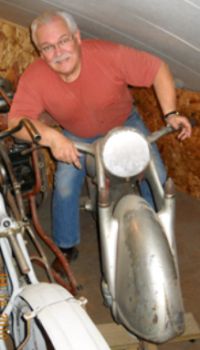 Freund. His frontal area—especially
for a guy as portly as this—completely overwhelms the
package. Does anyone
really think that these pretty streamline style parts are
helping the motorcycle slip through the air with a rider
aboard? The effect of any streamlining is
neutralize.
Freund. His frontal area—especially
for a guy as portly as this—completely overwhelms the
package. Does anyone
really think that these pretty streamline style parts are
helping the motorcycle slip through the air with a rider
aboard? The effect of any streamlining is
neutralize.
This,
incidentally, leads me toward a discussion that is especially
interesting to me as a designer. Should a motorcycle be
designed to look good standing on its own, or should it be
designed to look good with a rider aboard. Again, this
is something that an automobile designer would never have to
think about, but it is an important question that motorcycle
designers probably should not ignore. I expect most
motorcycles throughout history have been designed with no
thought to how they look with a
rider.
But, back to the
Killinger & Freund. Beyond the issue of style, let’s
consider some of the engineering. Think
about the effects of that clever front “wheel-engine.”
Suspension improves with less un-sprung weight.
The un-sprung weight at the K&F’s front will be
tremendous; probably amounting to more than a quarter of the
weight of the whole package. This thing was probably a
real boneshaker. And what would it be like to do
maintenance on this motorcycle? But, I love the
Killinger &
Freund
because it is such an extreme and wonderful example from the
streamline era. I am so glad to know that it still
exists with many of the parts intact, and may be running and
back on the road in the future.
Editor’s
Note: Craig
Vetter continues his study to develop streamlining as a
practical and effective element in real-world motorcycling,
aimed at increasing fuel efficiency and reducing environmental
impact. To learn more, click here.

To the
K&F
A silver,
swoopy
Projectile to
the future;
Killinger und
Freund.
The Brough Superior
Inline
Four
By Mick
Duckworth
(4/27/2010)
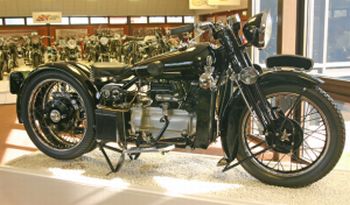 Although Brough Superiors sold mainly for
their speed and handling, flamboyant proprietor George Brough
yearned to create the ultimate in motorcycling luxury.
This ambition led to a series of four-cylinder designs,
all of which stand apart from the general run of contemporary
British offerings. Built in rapid succession in 1928 and
1929, the first fours had air-cooled side valve engines.
A transverse V-four was followed by a straight four,
both with crankshafts in-line with the frame. Transmissions
were fixed behind the crankcase in automobile fashion, but
90-degree bevel gears provided chain final
drive.
Although Brough Superiors sold mainly for
their speed and handling, flamboyant proprietor George Brough
yearned to create the ultimate in motorcycling luxury.
This ambition led to a series of four-cylinder designs,
all of which stand apart from the general run of contemporary
British offerings. Built in rapid succession in 1928 and
1929, the first fours had air-cooled side valve engines.
A transverse V-four was followed by a straight four,
both with crankshafts in-line with the frame. Transmissions
were fixed behind the crankcase in automobile fashion, but
90-degree bevel gears provided chain final
drive.
Neither design
offered effective cooling of the rear cylinders, a problem
addressed by the next four, sensationally revealed at the 1931
Motor Cycle Show at Olympia in London. Brough built it
around the water-cooled power unit of the popular Austin Seven
car. Power 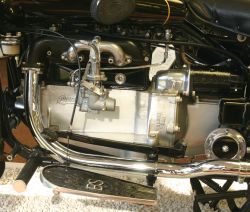 and torque were boosted by boring out
from 56mm to 57.9mm, raising displacement from 750cc with the
standard 76mm stroke to 800cc. Electric starting was
part of the package. This time, final drive was by shaft
with a helical bevel unit that did not need to be offset from
the machine’s center-line as there were two rear wheels,
placed on either side of the drive. The bevel box was carried
by two horizontal tubes extending back from the main frame,
which supported the power unit on a rectangle of stout tubes
with cross-bracing.
and torque were boosted by boring out
from 56mm to 57.9mm, raising displacement from 750cc with the
standard 76mm stroke to 800cc. Electric starting was
part of the package. This time, final drive was by shaft
with a helical bevel unit that did not need to be offset from
the machine’s center-line as there were two rear wheels,
placed on either side of the drive. The bevel box was carried
by two horizontal tubes extending back from the main frame,
which supported the power unit on a rectangle of stout tubes
with cross-bracing.
Radiators were
set either side of the down tubes, with sheet metal surrounds
to provide weather protection, also offered by generous
valancing of the rear fenders. Aluminum footboards were
provided for comfort, with pedals for the clutch on the left
and brake on the right. The Zenith carburetor was operated by
cable from a twistgrip on the left handlebar, leaving the
rider’s right hand free to select three forward gear ratios
and – great for entertaining onlookers -
reverse.
The 1931 show
exhibit had a sidecar attached. Those who questioned
whether it could be ridden without one were answered when
Hubert 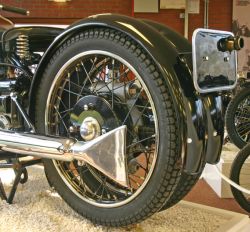 Chantrey completed the 1932 London to
Exeter long distance trial on a solo machine, reporting his
exploits in Motor Cycling. When cornering, only
one rear tire is in contact with the road.
Chantrey completed the 1932 London to
Exeter long distance trial on a solo machine, reporting his
exploits in Motor Cycling. When cornering, only
one rear tire is in contact with the road.
Ten Austin Fours
were built: selling at £160 the model was less successful than
its 600cc Ariel Square Four contemporary, which cost a mere
£67. Even an Austin 7 car could be had for less.
The machine pictured here is displayed at Birmingham’s
National Motorcycle
Museum in
Great Britain. It was originally assembled by BS expert
Albert Wallis, based on a known example that had been
scrapped. It does not have radiator shrouds or deep rear
fender valances.
Brough’s more
promising flat four project—the Golden Dream—followed, but its
development was stymied by World War Two. To read our
Motohistory feature about the Brough Golden Dream, go to
Motohistory News & Views 12/4/2006. To access the
web site for the National Motorcycle Museum, UK, click here.
New Motorsportsfilms
web site
launched
(4/24/2010)
 Dick Lague, whose IGNITION3 production
company has produced outstanding documentaries from ISDE
events in recent years, has now launched Motorsportsfilm.com,
offering a comprehensive collection of the best automotive and
motorcycle DVDs from throughout the world. Lague says,
“You can try before you buy by previewing the best selling
shows so you will know what you are going to get.” He
adds, “The site has been designed to be easily searched, and
checkout is configured to be quick and direct. All major
credit cards are accepted, as well as PayPal and Google
Checkout.” To access the new site, click here.
Dick Lague, whose IGNITION3 production
company has produced outstanding documentaries from ISDE
events in recent years, has now launched Motorsportsfilm.com,
offering a comprehensive collection of the best automotive and
motorcycle DVDs from throughout the world. Lague says,
“You can try before you buy by previewing the best selling
shows so you will know what you are going to get.” He
adds, “The site has been designed to be easily searched, and
checkout is configured to be quick and direct. All major
credit cards are accepted, as well as PayPal and Google
Checkout.” To access the new site, click here.
Fast From the Past
arrives in
Newburgh
(4/21/2010)
Editor’s
Note: Motohistory is a
little more abbreviated this month than usual, mainly because
I was up to my ears in relocating the “Fast From the Past”
exhibit from Hershey, Pennsylvania to Newburgh, New
York. I faced similar circumstances last year when we
assembled the exhibit in Hershey (see Motohistory News &
Views 5/31/2009). At that time, I made an apology to
readers and offered a picture of myself in my Carhartt
overalls, my traditional garb for museum exhibit 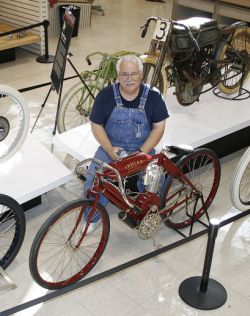 work. So many readers were amused
by that image that I decided to publish another this year,
just to prove I wasn’t just farting off this month. By
the way, my wife thinks it’s stupid. She can’t
understand why I can’t build an exhibit in jeans and t-shirt
like everyone else. Well, I just can’t! It’s an
image thing, you know. Like that guy wearing scrubs in
front of you in line every morning at
Starbucks.
work. So many readers were amused
by that image that I decided to publish another this year,
just to prove I wasn’t just farting off this month. By
the way, my wife thinks it’s stupid. She can’t
understand why I can’t build an exhibit in jeans and t-shirt
like everyone else. Well, I just can’t! It’s an
image thing, you know. Like that guy wearing scrubs in
front of you in line every morning at
Starbucks.
Through a
partnership between the Gerald A. Doering Foundation and the
Antique Motorcycle Foundation, later this year a new facility
will open that will provide nearly 50,000 square feet of
exhibit space, featuring motorcycles only. Located in
the Hudson Valley town of Newburgh, New York, the new facility
has some exhibits already in place while 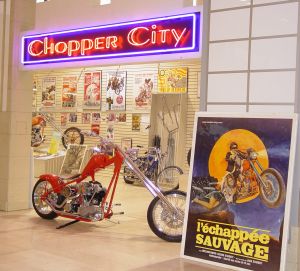 other portions of the building remain
under renovation. An opening date has not been
announced, but Motohistory will continue to report progress to
its readers.
other portions of the building remain
under renovation. An opening date has not been
announced, but Motohistory will continue to report progress to
its readers.
The main floor
will open with two distinctly different exhibits.
“Chopper Art: The 1960s Revisited,” featuring the collection
of Ted Doering, will tell the story of America’s unorthodox
motorcycle artists who developed the chopper into a rolling
art form during one of the greatest decades of social change
in American history. In addition 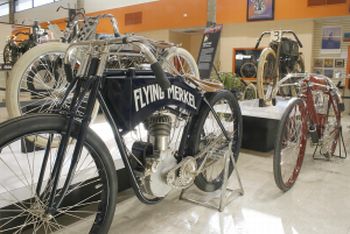 to examples by some of the leading
builders, such as Ron Finch and Ed "Big Daddy" Roth, the
display will include a rich collection of memorabilia,
including magazines and movie posters.
to examples by some of the leading
builders, such as Ron Finch and Ed "Big Daddy" Roth, the
display will include a rich collection of memorabilia,
including magazines and movie posters.
Sharing the same
floor with Chopper Art is an expanded version of “Fast From
the Past: The Competition Motorcycles of Yesteryear,” which
just completed its one-year run at the Antique Automobile Club
of America Museum in Hershey, Pennsylvania. 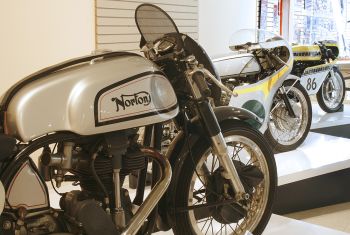 Composed of more than 60 motorcycles
owned by members of the Antique Motorcycle Club of American,
the exhibit depicts competition motorcycles from 1905 to the
1980s, including board track racers, road racing machines,
hill climbers, enduro and observed trials bikes, motocrossers,
dirt track machines, drag racing and speed trials bikes, and
even midget racing cars powered by motorcycle engines.
Composed of more than 60 motorcycles
owned by members of the Antique Motorcycle Club of American,
the exhibit depicts competition motorcycles from 1905 to the
1980s, including board track racers, road racing machines,
hill climbers, enduro and observed trials bikes, motocrossers,
dirt track machines, drag racing and speed trials bikes, and
even midget racing cars powered by motorcycle engines.
For another
story about the exhibit, go to Motohistory News & Views
3/25/2010.
Later-day Vincent
prototypes go to auction
(4/18/2010)
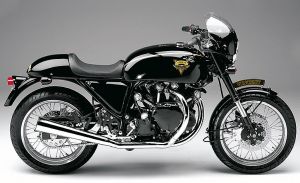 Four pre-production Vincent revival
concept bikes, developed by the late California entrepreneur
Bernard Li, will be auctioned by Bonhams’ at the Quail Lodge
Motorcycle Gathering on May 8. Starting in 1994, Li
acquired the United States Vincent trademark rights, then
commissioned an updated “Phase I” prototype using a modernized
version of the old Vincent motor (pictured above). When this
proved impractical for mass production, Li embarked on a
Four pre-production Vincent revival
concept bikes, developed by the late California entrepreneur
Bernard Li, will be auctioned by Bonhams’ at the Quail Lodge
Motorcycle Gathering on May 8. Starting in 1994, Li
acquired the United States Vincent trademark rights, then
commissioned an updated “Phase I” prototype using a modernized
version of the old Vincent motor (pictured above). When this
proved impractical for mass production, Li embarked on a 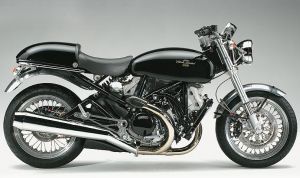 clean-sheet redesign, hiring Roush
Industries to build prototypes with modern engines. Li's
untimely death in 2008 brought the project to a halt.
The lots for auction will include the Phase 1 prototype with
Vincent engine, and three more prototype models with Honda
engines (pictured here). For more information about the
auction, click here.
To learn more about Li’s Vincent Motors venture, click here.
clean-sheet redesign, hiring Roush
Industries to build prototypes with modern engines. Li's
untimely death in 2008 brought the project to a halt.
The lots for auction will include the Phase 1 prototype with
Vincent engine, and three more prototype models with Honda
engines (pictured here). For more information about the
auction, click here.
To learn more about Li’s Vincent Motors venture, click here.

(4/16/2010)
How often do you
find a Hildebrand & Wulfmuller in your
basement? To read about one such case, click here.
For images of
the legendary Anke-Eve Goldman at Nurburgring
on Flickr, click here.
To read her story on The Vintagent web site, click here.
Bator
International Auctions has announced the California
Classic Motorcycle Auction at the Pasadena
Convention
Center on June 5. For more information, click here.
Bridgestone motorcycles
will be featured at AMA Vintage Motorcycle Days
2010. For more information, click here.
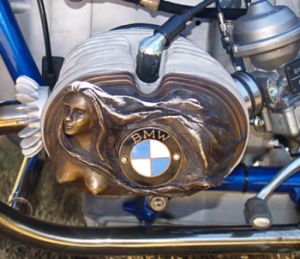 Hang the purists! If you want to
put sexy lady valve covers on your airhead BMW, then do it,
just like Craig Vechorik did with his 1969
BMW with Steib R75 conversion. For more photos on the
Bench Mark Works web site, click here.
Hang the purists! If you want to
put sexy lady valve covers on your airhead BMW, then do it,
just like Craig Vechorik did with his 1969
BMW with Steib R75 conversion. For more photos on the
Bench Mark Works web site, click here.
The
Wheels Through Time Museum web site has a
wonderful story about Creed and Virgie Kirkpatrick, who
relocated their whole family in 1933, using a 1929 JD and
sidecar, with the sidecar carrying all five of their
kids. This trek was recently re-enacted by descendants
with the help of WTTM. Click here.
WTTM’s Time Machine also treats us to a video
of a running 1913 Thor. Click here.
By the way, another of WTTM’s running rarities, the
one-of-a-kind 1912 Elk, was featured recently
on the Cyril Huze Blog. Click here.
There’s been a
lot of buzz about the up-coming Cannonball Endurance
Run for pre-1915 motorcycles. Well,
Chris Sommers Simmons has decided it’s not
just for the boys. Click here.
You have only
until May 7 to submit your design for the 30th Annual
Wings & Wheels logo, for which you could win $500
worth of books from Motorbooks. For more
information, click here.
The Spring issue
of the International Journal of Motorcycle
Studies has arrived. To read it, click here.
IGNITION3, the company
that has brought you excellent ISDE video documentaries, has
launched a new motorsports video web site. Click here.
How many of you
American readers remember fondly the Mustang,
built from 1947 through 1965? Well, the Mustang is
back. To read about it on the Motorcycle
Classics web site, click here.
To access the manufacturer's web site, click here.
The 19th
Heart of America Motorcycle Enthusiasts Bike Show and
Rally will take place June 6 at the Airline History
Museum at Wheeler Airport in Kansas City. For more
information, click here.
The
Goulding LS29 sidecar is now being accurately
replicated in Poland. For more information, click here.
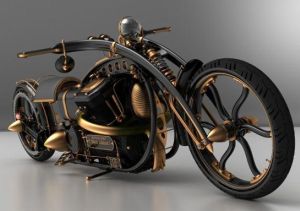 Seems like all we read about these days
is how our lives will be made greener by electric vehicles,
including electric motorcycles. But some would
prefer to return to steam. Check out the Black
Widow Steampunk Chopper. Sweet, huh? For more pix, click
here.
Seems like all we read about these days
is how our lives will be made greener by electric vehicles,
including electric motorcycles. But some would
prefer to return to steam. Check out the Black
Widow Steampunk Chopper. Sweet, huh? For more pix, click
here.
The Ohio
Valley BSA Owners Club Spring Classic will take place
June 5 and 6 at Cable's Campground near Toronto,
Ohio. For more information, click here.
The 2010
Triumph Come Home Rally is scheduled for June
18 through 20 at Spring, Grove, Pennsylvania. For more
information, click here.
The 38th
Paris National Canadian Vintage Motorcycle Group
Rally will take place at the Paris, Ontario
Fairgrounds June 18 through 20. For more information and
on-line registration, click
here.
The
Indian Motorcycle Rally at Hilltop Farm,
George Hendee's former estate in Suffield, Connecticut, will
take place July 17. For more information, click here.
The Cross Island
Motorcycle Club will celebrate its 60th anniversary on May
22. To reach Cross Island on the web, click here.
There is now a
Yahoo group for Reading Standard
enthusiasts. Click here.
Harley-Davidson
Museum restorer/conservator Bill Rodencal is
preparing a motorcycle for the Cannonball Endurance
Run. To watch him on YouTube, click here
and here.
Michael
Lichter's 10th Annual Sturgis Motorcycle
Exhibit will run August
7 through 13. To read about it on the Cyril Huze Blog,
click here.
To access Lichter's web site, click here.
Live in or
around Tennessee? The new Grease
Monkey magazine will tell you all about upcoming
meets and shows in the Volunteer state. Click here.
AMCA unveils new
Custom Culture judging class
(4/14/2010)
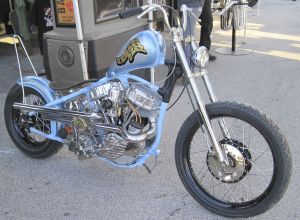 Two of this year’s Antique Motorcycle
Club of America national meets will feature a special Custom
Culture Class, designed to highlight ways that motorcyclists
express themselves through their machines. The class
will focus specifically on the era of the 1960s and early
’70s, the era when the custom-bike culture really took off,
culminating in the development of the American-style chopper
and the European cafe racer. The sole eligibility rule for
participating in judging is that bikes must have an engine
that was sold in a production motorcycle sometime between 1960
and 1975. Otherwise, entrants are free to take the
concept in any direction they choose.
Two of this year’s Antique Motorcycle
Club of America national meets will feature a special Custom
Culture Class, designed to highlight ways that motorcyclists
express themselves through their machines. The class
will focus specifically on the era of the 1960s and early
’70s, the era when the custom-bike culture really took off,
culminating in the development of the American-style chopper
and the European cafe racer. The sole eligibility rule for
participating in judging is that bikes must have an engine
that was sold in a production motorcycle sometime between 1960
and 1975. Otherwise, entrants are free to take the
concept in any direction they choose.
The Custom
Culture Class will be sponsored by prominent motorcycle
publications at two of the AMCA’s premiere National Meets this
season. Hot Bike magazine will sponsor the class at
the AMCA Fort Sutter Chapter National Meet June 18 through19
in Dixon, California, and Cycle Source magazine will
sponsor the class at the AMCA Chief Blackhawk Chapter National
Meet September 2 through 5 in Davenport, Iowa. The
winning bike at each event, as judged by magazine editors,
will be the subject of a feature story in the sponsoring
publication. Bike owners do not have to be members of
the AMCA to enter. For information about the Custom
Culture Class at the Fort Sutter meet,
click here.
For information about the class at the Chief Blackhawk meet,
click here.
For more information about the AMCA, click here.
Eyes On Design
is looking for a few good
motorcycles
(4/12/2010)
 This year’s Eyes On Design show will be
held again at the historic Edsel B. & Eleanor Ford estate
on the shores of lake St.Clair in
Grosse Pointe, Michigan on June 20th. This
invitation-only event is a high-end concours d' elegance that
will feature approximately 200 cars, 25 motorcycles, and
twelve scooters. If you have a significant and
interesting motorcycle or scooter that you think may qualify
for presentation, contact Andrew Sirvio at asirvio@sisuprint.com.
Vehicles of any nation of origin are eligible. For
more information about Eyes On Design, click here.
This year’s Eyes On Design show will be
held again at the historic Edsel B. & Eleanor Ford estate
on the shores of lake St.Clair in
Grosse Pointe, Michigan on June 20th. This
invitation-only event is a high-end concours d' elegance that
will feature approximately 200 cars, 25 motorcycles, and
twelve scooters. If you have a significant and
interesting motorcycle or scooter that you think may qualify
for presentation, contact Andrew Sirvio at asirvio@sisuprint.com.
Vehicles of any nation of origin are eligible. For
more information about Eyes On Design, click here.
Motohistorians get discount
at Roll On Columbus
(4/10/2010)
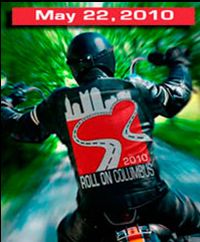 If you live in the American Midwest, you
may want to drop in on Roll On Columbus, a one-day event to
raise funds for Nationwide Children’s Hospital. The May
22 event, taking place in the Arena District in downtown
Columbus, Ohio, will feature four live bands, the motosphere,
observed trials exhibitions, extreme riding shows for
motorcycles and quads, a scooter gymkhana, safety exhibitions,
seminars, a silent auction, venders, and a drawing for a
$25,000 custom bobber. It will be a non-stop
extravaganza of motorcycle-related entertainment, all kicked
off by the Ohio State University Buckeyes Alumni
Band.
If you live in the American Midwest, you
may want to drop in on Roll On Columbus, a one-day event to
raise funds for Nationwide Children’s Hospital. The May
22 event, taking place in the Arena District in downtown
Columbus, Ohio, will feature four live bands, the motosphere,
observed trials exhibitions, extreme riding shows for
motorcycles and quads, a scooter gymkhana, safety exhibitions,
seminars, a silent auction, venders, and a drawing for a
$25,000 custom bobber. It will be a non-stop
extravaganza of motorcycle-related entertainment, all kicked
off by the Ohio State University Buckeyes Alumni
Band.
Admission is $15
at the gate or $12 through advanced registration.
Furthermore, Motohistory readers who register in advance can
take off a dollar, lowering their cost to $11.00. For
more information, click, here. To order
your tickets, click to the “Event Tix” page at
Rolloncolumbus.com. 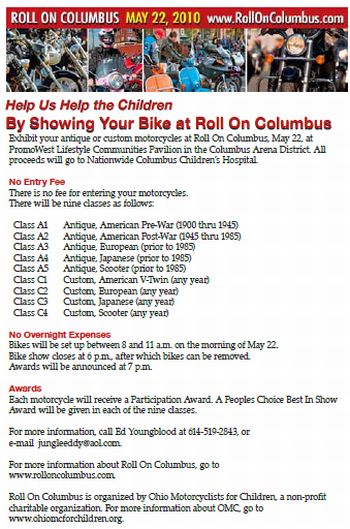 To order tickets with our
Motohistory discount, click here.
To order tickets with our
Motohistory discount, click here.
In addition to
all of the outdoor entertainment described above, there will
also be indoor antique and custom bike shows. There is
no entry fee for the bike shows, each participant will get a
plaque, and there will be a People’s Choice Best In Show award
in each of the two categories. More information and
classes are provided in the flyer published
here.
Proceeds from
the event will go to Nationwide Children’s Hospital. For
more info on the hospital, click here.
There’s just nothing
for a
vintage biker to do
(4/8/2010)
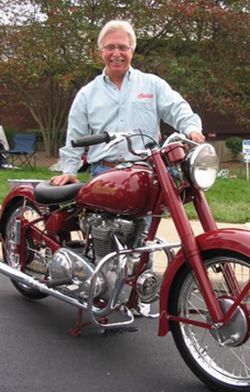 Motohistory contributor Larry Barnes
(pictured here) recently submitted his “2010 nothing to do”
list of activities for a vintage motorcycle enthusiast.
And this is just in the eastern US.
Motohistory contributor Larry Barnes
(pictured here) recently submitted his “2010 nothing to do”
list of activities for a vintage motorcycle enthusiast.
And this is just in the eastern US.
May
1-2
Massillon, OH Rocky’s AAIMC Spring Fling
May
14-16 Denton, NC Antique
Club Meet
May
22
Columbus, OH Roll On Columbus Bike Show
May
23
Greenville, OH AHRMA race
May
29-30 Canton, OH
race
June
4-6
Ithaca, NY Festival & Bike Ride
June
11
Dayton, OH AHRMA race
June
11-13 Rhinebeck, NY
Antique Meet
June
18-19 Canton Blues
Festival
June 19-20 Dux
Fathers Day AAIMC Meet
June
26
Lima AMA Pro race
July
9-11 Ashland
race & AMA Vintage Days
July
16
Wauseon Race & Antique Meet
July
30-31 Morgantown, WV
Meet
Aug. 5-12
Sturgis
Aug.
6-7
Hammondsport, NY Classic Giro
Aug.
14
Grove City AMA Pro mile
Aug.
28
Indy Mile AMA Pro race
Aug.
29
Indianapolis AMA-FIM Road Race
Sept.
2-4 Davenport
Antique Meet
Sept.
4
Springfield Mile AMA Pro Race
Sept
18-19 Hartman Wellington
AAIMC Meet
Sept.
23-26 Horner’s Asheville, SC
Ride-In
Sept. 25-26
Medina, OH Vintage MX races
Oct.
1-3
Jefferson, PA antique meet
Oct.
8-10 Barber Vintage
MC Festival
And this
isn’t even a comprehensive list. There are also the May
14 Riding into History Concours if St. Augustine, FL, the June
11-13 Elkhart Lake, WI Road America Vintage Motorcycle
Classic, and the July 9-11 Vintage Motorcycle Days, plus many
more Antique Motorcycle Club of America Nationals and
Walneck’s swap meets. To check out the AMCA schedule,
click here.
For the Walneck’s schedule, click here.
To read our feature story about Larry Barnes, go to
Motohistory News & Views 4/11/2005.
Larry, have you
discussed this plan with your wife yet?

(4/6/2010)
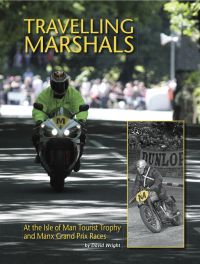 How do the organisers of the Isle of Man
TT manage racing over its 37¾ mile Mountain Course when its
grandstand-based race controllers can only see a 500 yard
stretch of the track? As explained in
“Travelling Marshals at the Isle of Man Tourist Trophy
and the Manx Grand Prix Races,” by David Wright, much
reliance is placed on the 1,200 static marshals who are
positioned within sight of each other, equipped with radios.
However, when racing started over the Mountain Course in
1911, marshals were few and radios did not exist. Once
riders had started the race, it was pretty much a case of
fingers crossed and hope for the best. This changed in
1935 when a Travelling Marshal service was created, which
today consists of eight or more former riders on top sports
bikes who remain on station at prescribed points unless called
upon to speed to an incident. Some 75 men—including five
former world champions—have performed this critical duty, and
their exciting story has been told in Wright’s book (2001),
which has been reprinted in celebration of the 75th
anniversary of the founding of the travelling marshal
system. Brought up to date with an enlarged format, this
book contains more than 240 illustrations on its 270
pages. It is published by Amulree Publications of Laxey,
IOM. To order a copy, click http://www.amulree@mcb.net.
How do the organisers of the Isle of Man
TT manage racing over its 37¾ mile Mountain Course when its
grandstand-based race controllers can only see a 500 yard
stretch of the track? As explained in
“Travelling Marshals at the Isle of Man Tourist Trophy
and the Manx Grand Prix Races,” by David Wright, much
reliance is placed on the 1,200 static marshals who are
positioned within sight of each other, equipped with radios.
However, when racing started over the Mountain Course in
1911, marshals were few and radios did not exist. Once
riders had started the race, it was pretty much a case of
fingers crossed and hope for the best. This changed in
1935 when a Travelling Marshal service was created, which
today consists of eight or more former riders on top sports
bikes who remain on station at prescribed points unless called
upon to speed to an incident. Some 75 men—including five
former world champions—have performed this critical duty, and
their exciting story has been told in Wright’s book (2001),
which has been reprinted in celebration of the 75th
anniversary of the founding of the travelling marshal
system. Brought up to date with an enlarged format, this
book contains more than 240 illustrations on its 270
pages. It is published by Amulree Publications of Laxey,
IOM. To order a copy, click http://www.amulree@mcb.net.
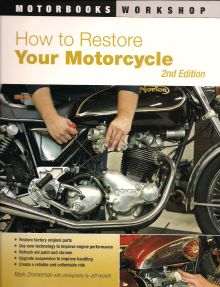 Motorbooks has released its second
edition of “How to Restore Your Motorcycle,”
by Mark Zimmerman with photography by Jeff Hackett.
Printed in full color throughout, this 192 page book is packed
with photographs, and color coded tabs are provided for each
chapter to make reference work quick and easy. Whether
you are restoring for concours competition, or just to have an
inexpensive and reliable daily ride, the book explains how to
use new technology to improve engine performance, how to
refresh old paint and chrome, and how to upgrade suspension
and handling. There is an index and an appendix with
many additional useful sources and references. The price
is $29.99 in the US, $32.99 in Canada, and £18.99 in the
UK. For more information, click here.
Motorbooks has released its second
edition of “How to Restore Your Motorcycle,”
by Mark Zimmerman with photography by Jeff Hackett.
Printed in full color throughout, this 192 page book is packed
with photographs, and color coded tabs are provided for each
chapter to make reference work quick and easy. Whether
you are restoring for concours competition, or just to have an
inexpensive and reliable daily ride, the book explains how to
use new technology to improve engine performance, how to
refresh old paint and chrome, and how to upgrade suspension
and handling. There is an index and an appendix with
many additional useful sources and references. The price
is $29.99 in the US, $32.99 in Canada, and £18.99 in the
UK. For more information, click here.
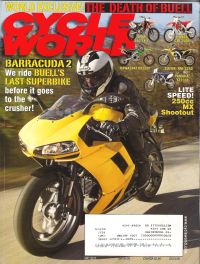 The May issue of Cycle
World might well be subtitled “The Buell Requiem
Issue.” Peter Egan describes the experience of picking
over the bones of Buell Motorcycles, the company, during its
liquidation sale, Dan Canet describes a ride on the Buell
Baracuda 2 prototype before its date with the crusher, and
Steve Anderson pens a feature entitled “The Demise of the
Buell Motorcycle Company.” This is a remarkable piece of
journalism that reveals the behind-the-scenes problems,
policies, and decisions that went into the termination of the
corporation. The story is not at all complementary of
the Harley-Davidson Motor Company, neither of its
decision-making processes nor its entrenched culture that
would result in abandoning the two properties—MV Agusta being
the other—that might give Harley-Davidson some hope of
reaching younger generations of customers. This article
is insightful and sound motohistory. It will become a
standard reference for future motohistorians exploring the
progress of Harley-Davidson in the 21st century. To
subscribe to Cycle World on line, E-mail
cycleworld@neodata.com.
The May issue of Cycle
World might well be subtitled “The Buell Requiem
Issue.” Peter Egan describes the experience of picking
over the bones of Buell Motorcycles, the company, during its
liquidation sale, Dan Canet describes a ride on the Buell
Baracuda 2 prototype before its date with the crusher, and
Steve Anderson pens a feature entitled “The Demise of the
Buell Motorcycle Company.” This is a remarkable piece of
journalism that reveals the behind-the-scenes problems,
policies, and decisions that went into the termination of the
corporation. The story is not at all complementary of
the Harley-Davidson Motor Company, neither of its
decision-making processes nor its entrenched culture that
would result in abandoning the two properties—MV Agusta being
the other—that might give Harley-Davidson some hope of
reaching younger generations of customers. This article
is insightful and sound motohistory. It will become a
standard reference for future motohistorians exploring the
progress of Harley-Davidson in the 21st century. To
subscribe to Cycle World on line, E-mail
cycleworld@neodata.com.
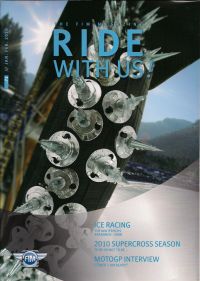
“Yikes, spikes!”
is what you might say when you see the cover of the
January/February issue of Ride With
Us!, the magazine of the International
Motorcycle Federation. Consistent with the cover, inside
is a history of ice racing, written by FIM press officer Marc
Petrier. The story explains how the sport has progressed
on the world stage, from a series of international
competitions to the creation of an European Championship, the
development of national team competitions, and finally the
creation of an individual Grand Prix system in 1994. For
more information about the FIM,
click here.
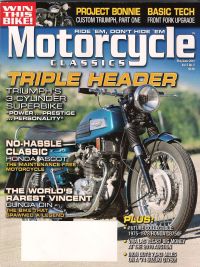 The May/June of
Motorcycle Classics features the
Triumph Triple on its cover, describing it as a motorcycle
that offered power, prestige, and personality. These
qualities, the story points out, were not enough to fend off
the exciting new Honda 750 Four in the marketplace, especially
since the Honda sold for $300 less than the Triumph in the
United States. The issue also contains features about
Vincent's famous Gunga Din, a rare Ceccato twin-cam racer from
the Guy Webster collection, the spectacular collection of
cutaway engines and motorcycles owned by Herb Harris, the 1984
Honda Ascot twin, a latter-day Bonneville build, Indian and
Harley tank-shift racers Ralph Wessel and Ross Tuffli, a
long-distance tour aboard a Suzuki Water Buffalo, and results
of the 2010 Las Vegas auction. As always, there is
variety and the photography is gorgeous. To subscribe,
click here.
The May/June of
Motorcycle Classics features the
Triumph Triple on its cover, describing it as a motorcycle
that offered power, prestige, and personality. These
qualities, the story points out, were not enough to fend off
the exciting new Honda 750 Four in the marketplace, especially
since the Honda sold for $300 less than the Triumph in the
United States. The issue also contains features about
Vincent's famous Gunga Din, a rare Ceccato twin-cam racer from
the Guy Webster collection, the spectacular collection of
cutaway engines and motorcycles owned by Herb Harris, the 1984
Honda Ascot twin, a latter-day Bonneville build, Indian and
Harley tank-shift racers Ralph Wessel and Ross Tuffli, a
long-distance tour aboard a Suzuki Water Buffalo, and results
of the 2010 Las Vegas auction. As always, there is
variety and the photography is gorgeous. To subscribe,
click here.
Vintage Motorcycle Classic
coming to Road
America
(4/4/2010)
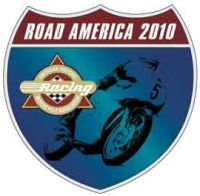 The American Historic Racing Motorcycle
Association has held national road races at Road America
before, but this year's meeting, scheduled for June 11 through
13, will be an expanded extravaganza that will include
motocross, trials, and cross country racing. The
full-blown vintage festival will also include a ride and show
sponsored by Motorcycle Classics magazine, plus club
corrals and a swap meet organized by Classic Swap Meets.
About the event, Road America President George
Bruggenthies said, “The world of vintage motorcycling is a
vibrant, diverse family that includes, collectors, restorers
and enthusiasts who just love to ride old bikes, as well as
racers. We’re throwing a family reunion!” To
read about it, click here
and here.
For a swap meet vendor application, click here.
The American Historic Racing Motorcycle
Association has held national road races at Road America
before, but this year's meeting, scheduled for June 11 through
13, will be an expanded extravaganza that will include
motocross, trials, and cross country racing. The
full-blown vintage festival will also include a ride and show
sponsored by Motorcycle Classics magazine, plus club
corrals and a swap meet organized by Classic Swap Meets.
About the event, Road America President George
Bruggenthies said, “The world of vintage motorcycling is a
vibrant, diverse family that includes, collectors, restorers
and enthusiasts who just love to ride old bikes, as well as
racers. We’re throwing a family reunion!” To
read about it, click here
and here.
For a swap meet vendor application, click here.
Don Brown, 1929 --
2010
(4/2/2010)
 Don Brown, a lifelong member and
significant contributor to the American motorcycle industry,
died at the age of 80 at his home in Irvine, California on
March 24. Brown became involved in motorcycling as a
sportsman in 1949, and shortly thereafter joined the industry
as a journalist. He aggressively promoted the motorcycle
sport through his writing and as a radio commentator, then
landed a position as general sales manager at Johnson Motors,
importer of Triumph and Ariel. During his time with
JoMo, one of his many important contributions was his
collaboration with designer Craig Vetter in the creation of
the famous Triumph Hurricane. To read Brown's
Motohistory dialogue with Vetter about this project, click here.
Brown went on to found his own market research
organization, numbering most of the major brands and the
Motorcycle Industry Council among his clients. He was a
member of the Motorcycle Hall of Fame and received both the
MIC Chairman Award and the Trailblazers Lifetime Achievement
Award. Brown was a good friend to Motohistory, often
providing research and historical insight. To read his
Motorcycle Hall of Fame bio, click here.
For an obit by Don Emde at SuperbikePlanet, click here.
To read a memorial on Dealernewsblog, click here.
Don Brown, a lifelong member and
significant contributor to the American motorcycle industry,
died at the age of 80 at his home in Irvine, California on
March 24. Brown became involved in motorcycling as a
sportsman in 1949, and shortly thereafter joined the industry
as a journalist. He aggressively promoted the motorcycle
sport through his writing and as a radio commentator, then
landed a position as general sales manager at Johnson Motors,
importer of Triumph and Ariel. During his time with
JoMo, one of his many important contributions was his
collaboration with designer Craig Vetter in the creation of
the famous Triumph Hurricane. To read Brown's
Motohistory dialogue with Vetter about this project, click here.
Brown went on to found his own market research
organization, numbering most of the major brands and the
Motorcycle Industry Council among his clients. He was a
member of the Motorcycle Hall of Fame and received both the
MIC Chairman Award and the Trailblazers Lifetime Achievement
Award. Brown was a good friend to Motohistory, often
providing research and historical insight. To read his
Motorcycle Hall of Fame bio, click here.
For an obit by Don Emde at SuperbikePlanet, click here.
To read a memorial on Dealernewsblog, click here.
Don Brown photo
from Dealernewsblog.com.
